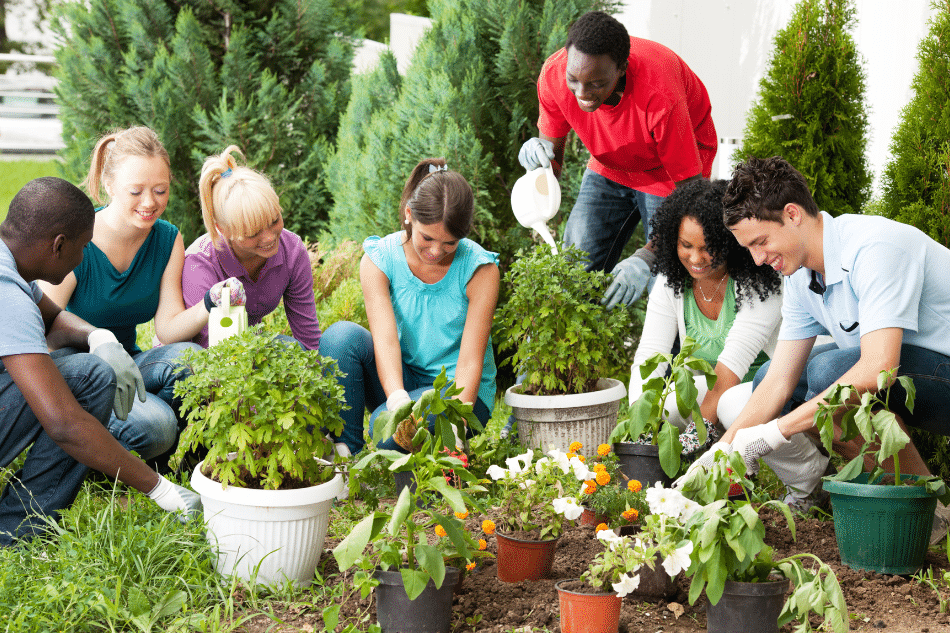What Is Horticultural Therapy? The Benefits of Gardening for Teen Mental Health

- What horticultural therapy is
- How gardening helps emotional health
- What gardening-based activities are included in horticultural therapy
- How Mission Prep can help with horticultural therapy for teens

What Is Horticultural Therapy?
Horticultural therapy aims to use gardening to support both mental and emotional health. This type of therapy is based on deep psychological principles, with a strong focus on our biological drive to connect with nature.¹ This is a concept known as the “biophilia hypothesis.”² It was introduced by biologist E.O. Wilson, who suggested that humans have a built-in tendency to seek out connection with the natural world. And tapping into this innate drive is what makes gardening a powerful tool for teens to use during emotional repair.
Gardening is a slow-paced and relational practice. This makes it very different from tech-driven distractions like scrolling or binge-watching television. Planting, watering, and pruning offer a type of predictability, driving a sense of calm when everything else seems chaotic. For this reason, mental health through horticulture is increasingly seen as more than a hobby. It’s a form of regulated exposure to stability, connection, and growth, which are three things that a dysregulated nervous system deeply craves.
Horticultural therapy first emerged as a formal practice in World War I.³ Veterans recovering in hospitals were encouraged to tend gardens as part of their treatment. It became more popular in the 1950s and ‘60s, when it became an officially recognized form of therapy.
Horticultural therapy is well-respected nowadays and is commonly used in treatment centers and support groups as an evidence-based way to minimize stress and promote emotional regulation.⁴ It may be especially helpful for those who struggle to talk and prefer to work through their feelings physically. Additionally, research suggests that horticultural therapy promotes peer attachment and improves social skills.⁵
How Gardening Helps Emotional Health
Gardening doesn’t just feel good; it triggers measurable shifts in brain chemistry. Research indicates that engaging with plants, soil, and the outside world leads the body to start producing dopamine and serotonin.⁶ These two neurotransmitters regulate mood, motivation, and emotional balance.
In fact, studies have found that contact with a specific soil bacterium (Mycobacterium vaccae) stimulates serotonin production and reduces anxiety.⁷ In other words, there’s a biochemical reason why pulling weeds or planting seeds can lift a low mood.
The benefits of gardening for mental health go beyond just brain chemicals. Gardening naturally pulls teens into the here and now, which is often the goal in mindfulness practices.⁸ The repetitive, tactile act of caring for plants helps quiet the amygdala, which handles threat detection. It also wakes up the prefrontal cortex, the part of the brain tied to staying calm, thinking things through, and making choices. These areas often work a bit differently in teens who are dealing with things like trauma, anxiety, or depression.⁹
Based on these effects, it’s easy to see why plant-based therapy is increasing in popularity. Gardening gets the whole body involved. It’s physical, sensory, and something teens can feel connected to, even when talking feels like too much. Repair can happen when you’re taking care of something living.
And for a lot of teens, this care turns into confidence. Watching something you tended to with your own hands grow can slowly build the belief that change is possible. This progress doesn’t have to be big or fast – sometimes it starts with a seed and some patience.
Why Horticultural Therapy Works When Talk Therapy Stalls
Some teens don’t respond immediately to talking therapy. It might not be to do with resistance. Perhaps they feel uncomfortable, or emotions just seem too raw. Often, a dysregulated nervous system needs to be calmed before talking feels possible.
When the body is in a chronic state of stress or shutdown, logic often takes a back seat. As a result, a teen may struggle to find the words to describe what they’re feeling. Even well-meaning therapeutic conversations can feel like pressure rather than relief. This is where nature becomes useful.
Horticultural therapy offers a different avenue into healing. It doesn’t require verbal clarity or emotional fluency to begin. The act of touching soil, nurturing a plant, or simply noticing the changes in a garden allows the body to regulate itself through experience, not explanation. These are bottom-up processes where the hands move, the breath slows, the eyes focus, and the mind starts to follow. In short, the physical rhythm of gardening teaches the internal system how to calm down.
In teens who’ve experienced trauma, neurodivergence, or emotional overwhelm, this somatic route can be especially powerful. And because gardening is inherently nonjudgmental, it also removes performance anxiety. No one expects perfect insight or flawless articulation. It’s enough to show up, observe, and try.
For teens who feel like they’ve failed therapy, or like therapy has failed them, horticultural therapy creates a space where healing is allowed to be quiet, physical, and deeply personal.
Garden-Based Healing Activities
Therapeutic gardening doesn’t require a sprawling greenhouse or a perfect climate. In fact, some of the most effective garden-based healing activities are simple, tactile, and deeply sensory. They’re designed to ground teens in the present moment while fostering emotional resilience.
Many youth gardening therapy programs use the following activities to build connection, reduce anxiety, and support trauma recovery.
Soil Meditation
When gardening, teens spend time with their hands in the earth, focusing on texture, temperature, and scent. This gentle practice engages the sensory nervous system, helping shift the body from a sympathetic fight-or-flight state into calm. Research shows that even the smell of soil can evoke feelings of relaxation.¹⁰ The repetitive, tactile nature of handling soil provides a natural anchor to the present moment, offering an accessible form of mindfulness for teens who may struggle with seated meditation.
Planting from Seed
Planting seeds and watching them grow is somewhat like the therapy process. Therapy is aimed at self-growth, which is slow, steady, and full of possibilities. When teens nurture something fragile and watch it grow into something strong, it teaches patience, consistency, and investment of time and energy to get results. In other words, teens may see their own growth and potential reflected in the plants they’re caring for.
Herb Care and Use
Research shows that the smell of herbs can reduce feelings of stress and anxiety.¹⁰ By growing lavender, mint, or chamomile, teens can have a multisensory experience. Plus, when growing herbs, teens learn about planting for a purpose. Herbs can be used to make calming teas, essential oils, or scent pouches, adding an element of accomplishment to their efforts.
Garden Journaling
Writing in a garden journal can build reflective capacity.¹¹ Teens observe the weather, note plant growth, or simply capture how they feel on a given day while among the greenery. This low-pressure writing helps track emotional patterns and fosters self-awareness. Journaling as part of mental health through horticulture creates a bridge between external observation and internal insight, which can be helpful for teens navigating mood disorders, trauma, or identity development.
Harvesting and Preparing
Picking produce, herbs, or flowers and then preparing something useful from them, like a salad, soup, or bouquet, builds a tangible connection between nourishment and self-worth.¹² This activity reinforces the idea that care and attention yield something of value. For teens struggling with disordered eating, self-esteem, or depression, therapeutic gardening offers a powerful metaphor that you are allowed to receive from the things you nurture.
Compost Building
Composting transforms waste like peels, clippings, and “mess” into something vital. In nature-based mental health treatment, compost becomes a metaphor for the emotional process. Pain, like organic waste, isn’t discarded. It’s integrated and transformed. Composting teaches teens that what feels broken or useless may, with time and the right conditions, become the soil for new growth.
These nature therapy for youth activities aren’t just calming; they help teens access parts of themselves that traditional talk therapy may not always reach.

Reach Out to Mission Prep to Access Horticultural Therapy for Teens
At Mission Prep, we believe healing should feel human, grounded, and accessible. Our horticultural therapy for teens isn’t just about planting seeds. It’s about rebuilding self-trust, finding calm through routine, and using the natural world as a partner in recovery.
Teens struggling with anxiety, depression, trauma, or stress often feel disconnected from their bodies and surroundings. Horticultural therapy gives them a way back. Our structured youth gardening therapy programs are guided by trained professionals and rooted in evidence-based practices that support emotional regulation, nervous system balance, and interpersonal growth.
Whether a teen is new to nature-based mental health treatment or already finds peace outdoors, our garden-based healing activities meet them where they are. If you think your teen could benefit from horticultural therapy, reach out to us. We’ll walk you through our approach, answer questions, and explore how therapeutic gardening can support your teen’s treatment journey.
References
- Passmore, H.-A., & Krause, A. N. (2023). The beyond-human natural world: Providing meaning and making meaning. International Journal of Environmental Research and Public Health, 20(12). https://pmc.ncbi.nlm.nih.gov/articles/PMC10298307/
- Gaekwad, J. S., Sal Moslehian, A., Roös, P. B., & Walker, A. (2022). A meta-analysis of emotional evidence for the biophilia hypothesis and implications for biophilic design. Frontiers in Psychology, 13, 750245. https://pmc.ncbi.nlm.nih.gov/articles/PMC9186521/
- Detweiler, M. B., Sharma, T., Detweiler, J. G., Murphy, P. F., Lane, S., Carman, J., Chudhary, A. S., Halling, M. H., & Kim, K. Y. (2012). What is the evidence to support the use of therapeutic gardens for the elderly? Psychiatry Investigation, 9(2), 100–110. https://pmc.ncbi.nlm.nih.gov/articles/PMC3372556/
- Curzio, O., Billeci, L., Belmonti, V., Colantonio, S., Cotrozzi, L., De Pasquale, C. F., Morales, M. A., Nali, C., Pascali, M. A., Venturi, F., Tonacci, A., Zannoni, N., & Maestro, S. (2022). Horticultural therapy may reduce psychological and physiological stress in adolescents with anorexia nervosa: A pilot study. Nutrients, 14(24), 5198. https://pmc.ncbi.nlm.nih.gov/articles/PMC9786778/
- Park, K.-H., Kim, S.-Y., & Park, S.-A. (2022). Efficacy of a horticultural therapy program designed for emotional stability and career exploration among adolescents in juvenile detention centers. International Journal of Environmental Research and Public Health, 19(14), 8812. https://pmc.ncbi.nlm.nih.gov/articles/PMC9319874/
- Lentoor, A. G. (2024). Effect of gardening physical activity on neuroplasticity and cognitive function. Exploration of Neuroprotection & Therapy, 4, 251–272. https://www.explorationpub.com/Journals/ent/Article/100481
- Holbrook, E. M., Zambrano, C. A., Wright, C. T. O., Dubé, E. M., Stewart, J. R., Sanders, W. J., Frank, M. G., MacDonald, A. S., Reber, S. O., & Lowry, C. A. (2023). Mycobacterium vaccae NCTC 11659, a soil-derived bacterium with stress resilience properties, modulates the proinflammatory effects of LPS in macrophages. International Journal of Molecular Sciences, 24(6). https://pmc.ncbi.nlm.nih.gov/articles/PMC10049321/
- Panțiru, I., Ronaldson, A., Sima, N., Dregan, A., & Sima, R. (2024). The impact of gardening on well-being, mental health, and quality of life: An umbrella review and meta-analysis. Systematic Reviews, 13(1), 45. https://systematicreviewsjournal.biomedcentral.com/articles/10.1186/s13643-024-02457-9
- American Psychological Association. (n.d.). Understanding the teenage brain, with Eva Telzer, PhD [Audio podcast episode]. In Speaking of Psychology. https://www.apa.org/news/podcasts/speaking-of-psychology/teenage-brain
- Morisawa, T., Hanyu, K., Mori, H., & Tamura, K. (2017). Physiological and psychological effects of scent of soil on human beings. Open Journal of Soil Science, 7(9), 265–275. https://www.scirp.org/journal/paperinformation?paperid=79064
- McClain, L. R., Powell, A. E., & Bettwy, K. A. (2024). Community nature journaling: Wellbeing and learning outcomes for adult and youth participants. Journal of Adventure Education and Outdoor Learning, 1–19. https://www.tandfonline.com/doi/full/10.1080/14729679.2024.2425933
- Alaimo, K., Coringrato, E., Lacy, K., Hébert, J. R., & Beavers, A. W. (2024). Caretaking, accomplishment and connection to nature: The “gardening triad” and its role in new community gardeners’ engagement, and social and emotional well-being. People and Nature. https://besjournals.onlinelibrary.wiley.com/doi/full/10.1002/pan3.10696
- Wood, C. J., Barton, J., & Wicks, C. L. (2024). Effectiveness of social and therapeutic horticulture for reducing symptoms of depression and anxiety: a systematic review and meta-analysis. Frontiers in Psychiatry, 15, 1507354. https://pmc.ncbi.nlm.nih.gov/articles/PMC11799672













